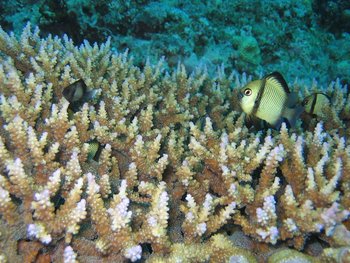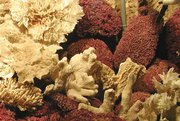Coral
|
|
Corals are gastrovascular marine cnidarians (phylum Cnidaria; class Anthozoa) existing as small sea anemone-like polyps, typically forming colonies of many individuals. The group includes the important reef builders known as hermatypic corals, found in tropical oceans, and belonging to the subclass Zoantharia of order Scleractinia (formerly Madreporaria). The latter are also known as stony corals inasmuch as the living tissue thinly covers a skeleton composed of calcium carbonate. A large scale coral is actually formed of many individual polyps, up to a few millimeters in diameter, which are individual organisms. However, they function as one organism by sharing nutrients via channels in the skeleton and are clones of each other, hence having the same DNA.
The hermatypic corals obtain much of their nutrient requirement from symbiotic unicellular algae called zooxanthellae, and so are dependent upon growing in sunlight. As a result, these corals are usually found not far beneath the surface, although in clear waters corals can grow at depths of 60 m (200 ft). Corals breed by spawning, with many corals of the same species in a region releasing gametes simultaneously over a period of one to several nights around a full moon.
Corals are major contributors to the physical structure of coral reefs that develop only in tropical and subtropical waters. Isolated corals exist even in cold waters, such as off the coast of Norway. The most extensive development of extant coral reef is the Great Barrier Reef off the coast of Queensland, Australia. Indonesia is home to 581 of the world's 793 known coral reef-building coral species.
| Contents |
Coral types
There are several other types of corals, notably the octocorals (subclass Octocorallia) and corals classified in other orders of subclass Zoantharia: to wit, the black corals (order Antipatharia) and the soft corals (order Zoanthinaria). Extinct corals include rugose corals and tabulate coral. These two groups went extinct at the end of the Paleozoic. Most other anthozoans would be treated under the common name of "sea anemone".
Geological history
Although corals first appeared in the Cambrian period, some 570 million years ago, they are extremely rare as fossils until the Ordovician period, when Rugose and Tabulate corals became widespread.
Tabulate corals occur in the limestones and calcareous shales of the Ordovician and Silurian periods, and often form low cushions or branching masses alongside Rugose corals. Their numbers began to decline during the middle of the Silurian period and they finally became extinct at the end of the Permian period. The skeletons of Tabulate corals are composed of a form of calcium carbonate known as calcite.
Rugose corals became dominant by the middle of the Silurian period, and became extinct early in the Triassic period. The Rugose corals may be either solitary or colonial, and like the Tabulate corals their skeletons are also composed of calcite. The finest details of their skeletal structures are often well preserved, and such fossils may be cut and polished.
Scleractinian corals diversified during the Mesozoic and Cenozoic eras and are at the height of their development today. Their fossils may be found in small numbers in rocks from the Triassic period, and they are relatively common fossils in rocks from the Jurassic and Cretaceous periods as well as the Caenozoic era. The skeletons of Scleractinian corals are composed of a form of calcium carbonate known as aragonite. Although they are geologically younger than the Tabulate and Rugose corals, the aragonite skeleton Scleractinian corals does not tend to preserve well, so it is often easier to find fossils of the more ancient Tabulate and Rugose corals.
At certain times in the geological past corals were very abundant, just as modern corals are in the warm clear tropical waters of certain parts of the world today. And like modern corals their fossil ancestors built reefs beneath the ancient seas. Some of these reefs now lie as great structures in the midst of sedimentary rocks. Such reefs can be found in the rocks of many parts of the world including those of the Ordovician period of Vermont, the Silurian period of the Michigan Basin and in many parts of Europe, the Devonian period of Canada and the Ardennes in Belgium, and the Cretaceous period of South America and Denmark. Reefs from both the Silurian and Carboniferous periods have been recorded as far north as Siberia, and as far south as Australia.
However, these ancient reefs are not composed entirely of corals. Algae and sponges, as well as the fossilized remains of many echinoids, brachiopods, bivalves, gastropods, and trilobites that lived on the reefs help to build them. These fossil reefs are prime locations to look for fossils of many different types, besides the corals themselves.
Corals are not restricted to just reefs, many solitary corals may be found in rocks where reefs are not present (such as Cyclocyathus which occurs in the Cretaceous period Gault clay formation of England).
As well as being important rock builders, some corals are useful as zone (or index) fossils, enabling geologists to date the age the rocks in which they are found, particularly those found in the limestones of the Carboniferous period.
Environmental effects on coral
Coral can be sensitive to environmental changes, and as a result are generally protected through environmental laws. A coral reef can easily be swamped in algae if there is too much nitrogen in the water. Coral will also die if the water temperature changes by more than a degree or two beyond its normal range or if the salinity of the water drops. In an early symptom of environmental stress, corals expel their zooxanthellae; without their symbiotic unicellular algae, coral tissues are colorless, revealing the white of their calcium carbonate skeletons, an event known as 'coral bleaching'.
A combination of temperature changes, pollution, and overuse has led to the destruction of many coral reefs around the world. This has increased the importance of coral biology as a subject of study. Climatic variations, such as El Niņo, can cause the temperature changes that destroy corals.
Corals and past climate
Some coral species exhibit banding in their skeletons resulting from annual variations in their growth rate. In fossil and modern corals these bands allow geologists to construct year-by-year chronologies, a kind of incremental dating, which combined with geochemical analysis of each band, can provide high-resolution records of paleoclimatic and paleoenvironamental change.
Uses
Coral reefs are a great source of tourism for scuba diving or snorkelling, however this has conservational implications due to damage from removal or destruction of coral.
Ancient coral reefs on land are often mined for limestone. An example of this is the quarrying of Portland limestone from the Isle of Portland.
Reddish coral is sometimes used as a gemstone especially in Tibet. Pure red coral is known as 'fire coral' and it is very rare because of the demand for perfect fire coral for jewellery-making purposes.
References
- Schrag, D. P., and Linsley, B. K., (2002), Corals, Chemistry, and Climate. Science 296 277-278.




